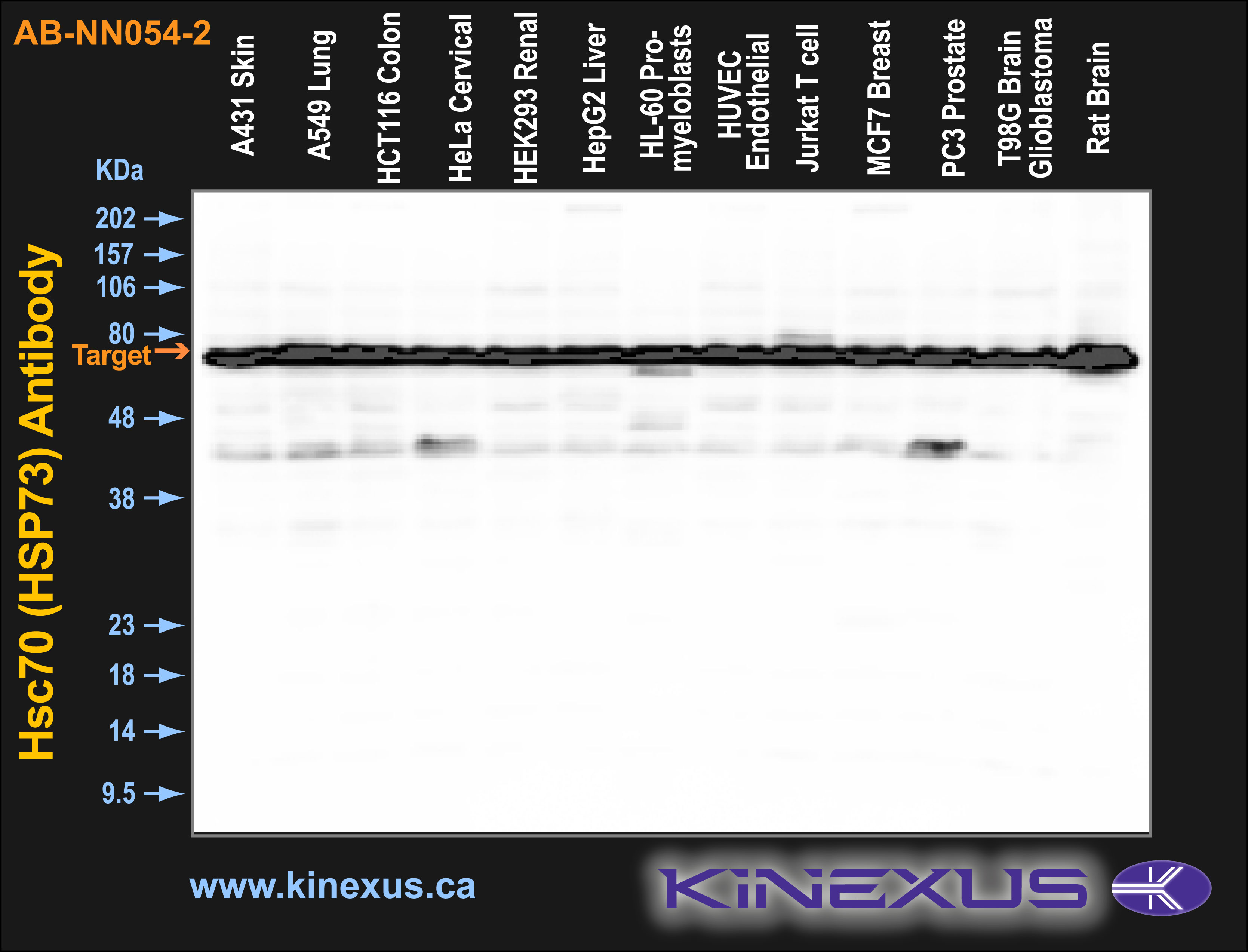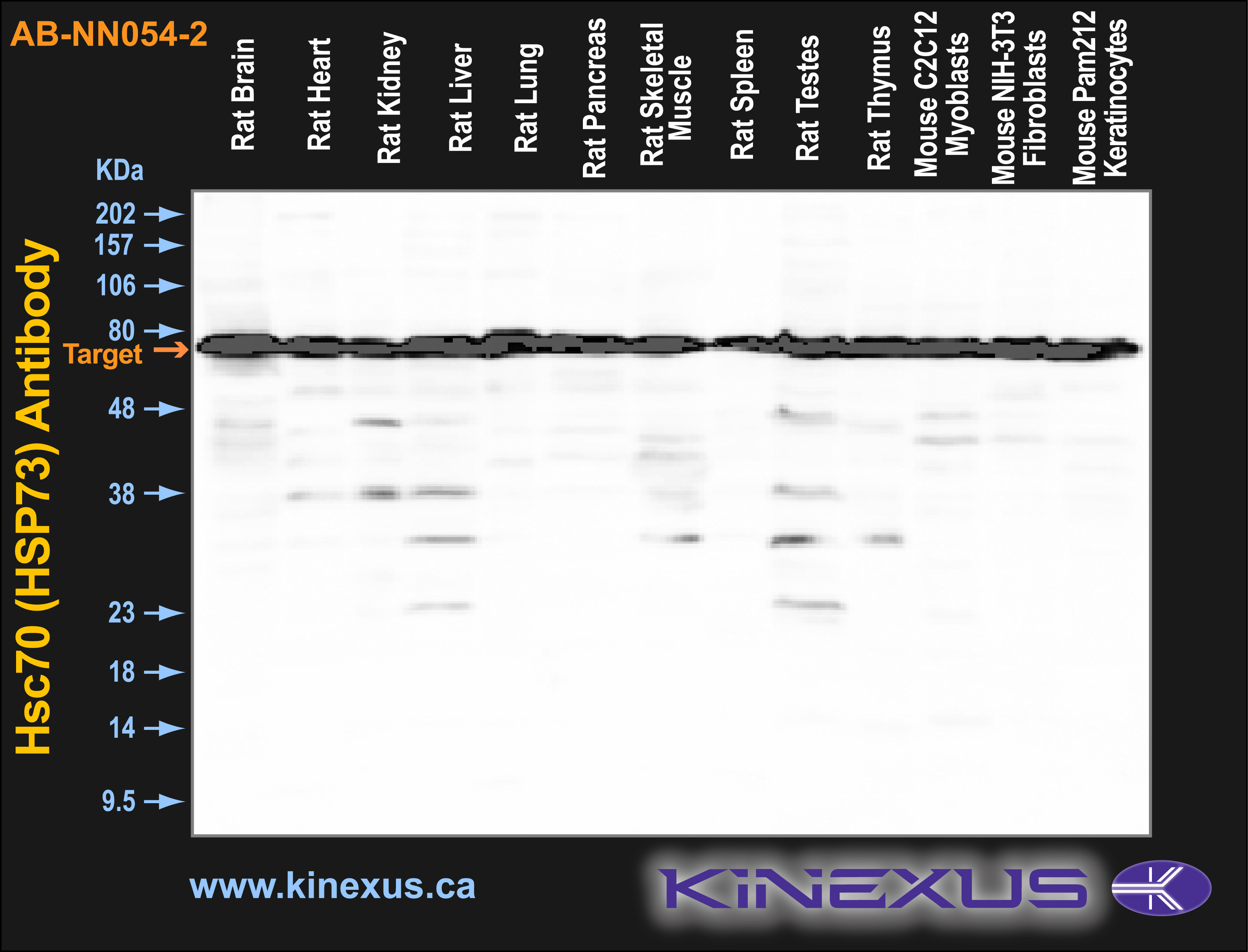Product Name: Hsc70 (Hsp73)
Product Number: AB-NN054-2
| Size: | 25 µl | Price: | 89.00 | |
| $US |
Target Full Name: Heat shock cognate 71 kDa protein
Target Alias: Hsc54; Hsc71; Hsc73; Hsp71; Hsp73; HspA10; HspA8; LAP1; NIP71
Product Type Specific: Heat shock/stress protein pan-specific antibody
Antibody Code: NN054-2
Antibody Target Type: Pan-specific
Protein UniProt: P11142
Protein SigNET: P11142
Antibody Type: Polyclonal
Antibody Host Species: Rabbit
Antibody Immunogen Source: Amino acids 618-637 of human hsc70
Production Method: Rabbit antiserum
Target Alias: Hsc54; Hsc71; Hsc73; Hsp71; Hsp73; HspA10; HspA8; LAP1; NIP71
Product Type Specific: Heat shock/stress protein pan-specific antibody
Antibody Code: NN054-2
Antibody Target Type: Pan-specific
Protein UniProt: P11142
Protein SigNET: P11142
Antibody Type: Polyclonal
Antibody Host Species: Rabbit
Antibody Immunogen Source: Amino acids 618-637 of human hsc70
Production Method: Rabbit antiserum
Antibody Modification: Unconjugated. Contact KInexus if you are interest in having the antibody biotinylated or coupled with fluorescent dyes.
Storage Buffer: Rabbit antiserum
Storage Conditions: For long term storage, keep frozen at -40°C or lower. Stock solution can be kept at +4°C for more than 3 months. Avoid repeated freeze-thaw cycles.
Antibody Dilution Recommended: 1:1500-2000 (WB), 1:250 (IF)
Antibody Potency: Detects a 73 kDa protein corresponding to the molecular mass of hsc70 on SDS-PAGE immunoblots. Does not cross-react with hsp70.
Antibody Species Reactivity: Human, Hamster, Rat
Storage Buffer: Rabbit antiserum
Storage Conditions: For long term storage, keep frozen at -40°C or lower. Stock solution can be kept at +4°C for more than 3 months. Avoid repeated freeze-thaw cycles.
Antibody Dilution Recommended: 1:1500-2000 (WB), 1:250 (IF)
Antibody Potency: Detects a 73 kDa protein corresponding to the molecular mass of hsc70 on SDS-PAGE immunoblots. Does not cross-react with hsp70.
Antibody Species Reactivity: Human, Hamster, Rat
Antibody Positive Control: 0.5 μg/ml of SPC-102 was sufficient for detection of Hsc70 20μg of heat shocked HeLa cell lysate by colorimetric immunoblot analysis using Goat anti-rabbit IgG:HRP as the secondary antibody.
Antibody Cross Reactivity: Does not cross-react with hsp70.
Related Product 1: HSC70 (HSP73) pan-specific antibody (Cat. No.: AB-NN054-4)
Antibody Cross Reactivity: Does not cross-react with hsp70.
Related Product 1: HSC70 (HSP73) pan-specific antibody (Cat. No.: AB-NN054-4)
Scientific Background: Hsp70 genes encode abundant heat-inducible 70-kDa hsps (hsp70s). In most eukaryotes hsp70 genes exist as part of a multigene family. They are found in most cellular compartments of eukaryotes including nuclei, mitochondria, chloroplasts, the endoplasmic reticulum and the cytosol, as well as in bacteria. The genes show a high degree of conservation, having at least 50% identity (2). The N-terminal two thirds of hsp70s are more conserved than the C-terminal third. Hsp70 binds ATP with high affinity and possesses a weak ATPase activity which can be stimulated by binding to unfolded proteins and synthetic peptides (3). When hsc70 (constitutively expressed) present in mammalian cells was truncated, ATP binding activity was found to reside in an N-terminal fragment of 44 kDa which lacked peptide binding capacity. Polypeptide binding ability therefore resided within the C-terminal half (4). The structure of this ATP binding domain displays multiple features of nucleotide binding proteins (5). >When cells are subjected to metabolic stress (e.g., heat shock) a member of the hsp 70 family, hsp 70 (hsp72), is expressed; hsp 70 is highly related to hsc70 (>90% sequence identity). Constitutively expressed hsc70 rapidly forms a stable complex with the highly inducible hsp70 in cells following heat shock. The interaction of hsc70 with hsp 70 is regulated by ATP. These two heat shock proteins move together in the cell experiencing stress. Furthermore, research on hsc70 has implicates it with a role in facilitating the recovery of centrosomal structure and function after heat shock (6).
Figure 1. Immunoblotting of various cell lines with AB-NN054-2 antibody at a 0.5 µg/mL final concentration. The target protein Hsc70 is indicated. Each lane was loaded with 15 µg of cell lysate protein. The max signal count was 65518.
Figure 2. Immunoblotting of various tissue lines with AB-NN054-2 antibody at a 0.5 µg/mL final concentration. The target protein Hsc70 is indicated. Each lane was loaded with 15 µg of tissue lysate protein. The max signal count was 65529.
References
[1] Brown C.L. et al. (1993) J.Cell Biol., 120 (5): 1101-1112.
[2] Boorstein W.R., Ziegelhoffer T., and Craig E.A. (1993) J. Mol. Evol. 38(1): 1-17.
[3] Rothman J. (1989), Cell 59: 591-601.
[4] DeLuca-Flaherty et al. (1990) Cell 62: 875-887.
[5] Bork P., Sander C., and Valencia A. (1992) Proc. Nut1 Acad. Sci. USA 89: 7290-7294.
[6] Brown C.L. et al. (1996) J. Biol. Chem. 271(2): 833- 840.
[1] Brown C.L. et al. (1993) J.Cell Biol., 120 (5): 1101-1112.
[2] Boorstein W.R., Ziegelhoffer T., and Craig E.A. (1993) J. Mol. Evol. 38(1): 1-17.
[3] Rothman J. (1989), Cell 59: 591-601.
[4] DeLuca-Flaherty et al. (1990) Cell 62: 875-887.
[5] Bork P., Sander C., and Valencia A. (1992) Proc. Nut1 Acad. Sci. USA 89: 7290-7294.
[6] Brown C.L. et al. (1996) J. Biol. Chem. 271(2): 833- 840.
© Kinexus Bioinformatics Corporation 2017



